Solution* for Chapter 1 Exercise*
Solutions for Chapter 1 Exercises
1.1 5, CPU
1.2 1, abstraction
1.3 3, bit
1.4 8, computer family
1.5 19, memory
1.6 10, datapath
1.7 9, control
1.8 11, desktop (personal computer)
1.9 15, embedded system
1.10 22, server
1.11 18, LAN
1.12 27, WAN
1.13 23, supercomputer
1.14 14, DRAM
1.15 13, defect
1.16 6, chip
1.17 24, transistor
1.18 12, DVD
1.19 28, yield
1.20 2, assembler
1.21 20, operating system
1.22 7, compiler
1.23 25, VLSI
1.24 16, instruction
1.25 4, cache •
1.26 17, instruction set architecture
�
Solutions for Chapter 1 Exercises
1.27 21, semiconductor
1.28 26, wafer
1.29
i
1.30 b
1.31 e
1.32
i
1.33 h
1.34 d
1.35 f
1.36 b
1.37 c
1.38 f
1.39 d
1.40 a
1.41 c
1.42
i
1.43 e
1.44 g
1.45 a
1.46 Magnetic disk:
Time for 1/2 revolution =1/2 rev x 1/7200 minutes/rev X 60 seconds/
minutes3 4.17 ms
Time for 1/2 revolution = 1/2 rev x 1/10,000 minutes/rev X 60 seconds/
minutes = 3 ms
Bytes on center circle = 1.35 MB/seconds X 1/1600 minutes/rev x 60
seconds/minutes = 50.6 KB
Bytes on outside circle = 1.35 MB/seconds X 1/570 minutes/rev X 60
seconds/minutes = 142.1 KB
1.48 Total requests bandwidth = 30 requests/sec X 512 Kbit/request = 15,360
Kbit/sec < 100 Mbit/sec. Therefore, a 100 Mbit Ethernet link will be sufficient.
�
Solution* for Chapter X Exarclsm
1.49 Possible solutions:
Ethernet, IEEE 802.3, twisted pair cable, 10/100 Mbit
Wireless Ethernet, IEEE 802.1 lb, no medium, 11 Mbit
Dialup, phone lines, 56 Kbps
ADSL, phone lines, 1.5 Mbps
Cable modem, cable, 2 Mbps
1.50
a. Propagation delay = mis sec
Transmission time = LIR sec
End-to-end delay =m/s+L/R
b. End-to-end delay =mls+ LJR+t
c. End-to-end delay = mis + 2I/R + f/2
1.51 Cost per die = Cost per wafer/(Dies per wafer x Yield) = 6000/( 1500 x 50%)
= 8
Cost per chip = (Cost per die + Cost_packaging + Cost_testing)/Test yield =
(8 + 10)/90% = 20
Price = Cost per chip x (1 + 40%) - 28
If we need to sell n chips, then 500,000 + 20« = 28», n = 62,500.
1.52 CISCtime = P x 8 r = 8 P r ns
RISC time = 2Px 2T= 4 PTns
RISC time = CISC time/2, so the RISC architecture has better performance.
1.53 Using a Hub:
Bandwidth that the other four computers consume = 2 Mbps x 4 = 8 Mbps
Bandwidth left for you = 10 - 8 = 2 Mbps
Time needed = (10 MB x 8 bits/byte) / 2 Mbps = 40 seconds
Using a Switch:
Bandwidth that the other four computers consume = 2 Mbps x 4 = 8 Mbps
Bandwidth left for you = 10 Mbps. The communication between the other
computers will not disturb you!
Time needed = (10 MB x 8 bits/byte)/10 Mbps = 8 seconds
�
Solutions for Chapter 1 EXWCIMS
1.54 To calculate d = a x f c - a x c, the CPU will perform 2 multiplications and 1
subtraction.
Time needed = 1 0 x 2 + 1 x 1 = 21 nanoseconds.
We can simply rewrite the equation &sd = axb-axc= ax (b-c). Then 1 multi-
plication and 1 subtraction will be performed.
Time needed = 1 0 x1 + 1x1 = 11 nanoseconds.
1.55 No solution provided.
1.56 No solution provided.
1.57 No solution provided.
1.68 Performance characteristics:
Network address
Bandwidth (how fast can data be transferred?)
Latency (time between a request/response pair)
Max transmission unit (the maximum number of data that can be transmit-
ted in one shot)
Functions the interface provides:
Send data
Receive data
Status report (whether the cable is connected, etc?)
1.69 We can write Dies per wafer = /((Die area)"1) and Yield = /((Die area)"2)
and thus Cost per die = /((Die area)3).
1.60 No solution provided.
1.61 From the caption in Figure 1.15, we have 165 dies at 100% yield. If the defect
density is 1 per square centimeter, then the yield is approximated by
1
= .198.
1 +
Thus, 165 x .198 = 32 dies with a cost of $1000/32 = $31.25 per die.
�
Solution* for Chapter 1 Exercises
1.62 Defects per area.
1 Yield =
1
(1 + Defects per area x Die a r e a / 2 )2
Defects per area = —:
j —L ••— - 1 |
1980
1992
1992 + 19S0
Die ares
Yield
Defect density
Die area
Yield
Defect density
improvement
0.16
0.48
5.54
0.97
0.48
0.91
6.09
�
Solutions for Chapter 2 ExardsM
Solutions for Chapter 2 Exercises
2.2 By lookup using the table in Figure 2.5 on page 62,
7ffififfohoi = 0111 1111 1111 1111 1111 1111 1
= 2,147,483,642^.
2.3 By lookup using the table in Figure 2.5 on page 62,
1100 1010 1111 1110 1111 1010 1100 111
Solutions for Chapttr 2
$zero
, Exit
$t2
, Exit
2
It4
. Ss5,
. $zero
, $s5,
, $zero
, Ss5,
, «tl.
0($tl)
.• fs3.
$s4
$S2
Js2
$s4
. fsl,
. tsl,
. fs3,
St3
Jt3
St3
$t3
Jtl
$tl
«to,
$to
$sO
sit
bne
sit
beq
sll
add
lw
jr
add
j Exit
add $sO
i Exit
sub $sO
3 Exit
sub $S0
i Exit
LO:
LI:
L2:
L3:
Exit
2.11
#
t
i
t
§
t
t
t
t
#
t
1
f
f
t
f
test k < 0
if so, exit
test k < 4
if not, exit
$tl - 4*k
$tl - SJumpTabletk)
$tO - JumpTable[k]
jump register
k — 0
break
k — 1
break
k — 2
break
k — 3
break
if (k—0) f - i + j;
else if (k—1) f - g + h;
else if (k—2) f - g - h;
else if (k—3) f - i - j:
�
Solutions for ChapUr 2 EJMKIMS
bne $s5, $0, Cl
add JsO, $s3, $s4 # f - 1 + j
j
Exit
# branch k != 0
Cl: addi $tO, $s5, -1
bne StO, tO. C2
add tsO. $sl. $s2
j
Exit
C2: addi $tO, $s5, -I
# break
# $tO - k - 1
# branch k !- 1
# f - g + h
# break
# $tO - k - 2
# branch k != 2
bne $tO, $0, C3
sub tsO, tsl, Ss2 # f - g - h
j
Exit
C3: addi StO, $s5, -3
bne $tO, $0, Exit
sub $sO, $s3, $s4 # f - 1 - j
# break
# $tO - k - 3
\\ branch k != 3
Exit:
c The MIPS code from the previous problem would yield the following
results:
(5 arithmetic) 1.0 + (1 data transfer) 1.4 + (2 conditional branch) 1.7
+ (2 jump) 1.2 = 12.2 cycles
while the MIPS code from this problem would yield the following:
(4 arithmetic) 1.0 + (0 data transfer)1.4 + (4 conditional branch) 1.7
+ (0jump)1.2 = 10.8 cycles
2.12 The technique of using jump tables produces MIPS code that is independent
of N, and always takes the following number of cycles:
(5 arithmetic) 1.0 + (1 data transfer) 1.4 + (2 conditional branch) 1.7
+ (2 jump) 1.2= 12.2 cycles
However, using chained conditional jumps takes the following number of cycles in
a worst-case scenario:
(Narithmetic)1.0+ (0datatransfer)1.4 +{Nconditionalbranch)1.7
+ (0jump)1.2 = 2.7Ncycles
Hence, jump tables are faster for the following condition:
N> 12.2/2.7 = 5 case statements
�
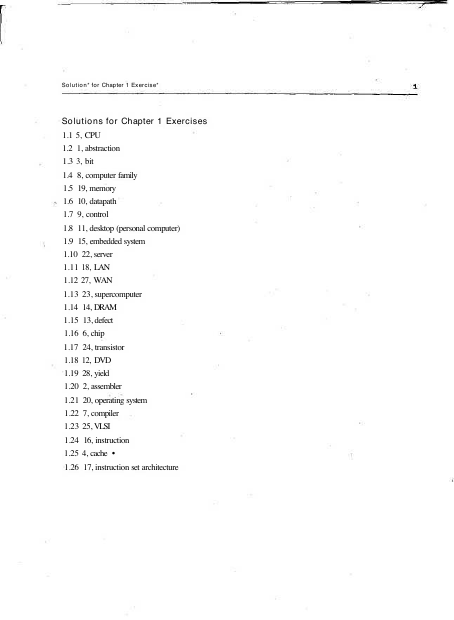
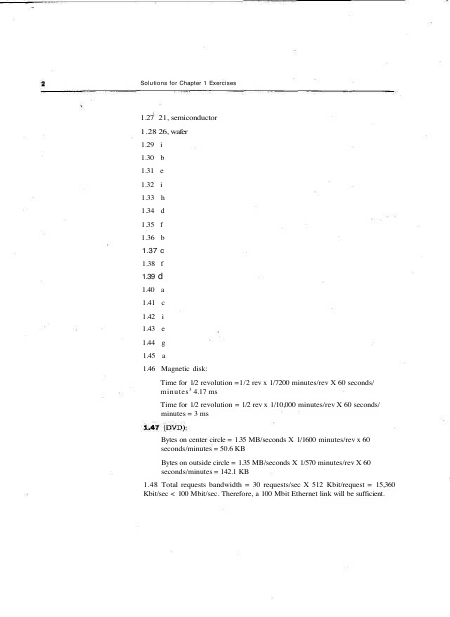

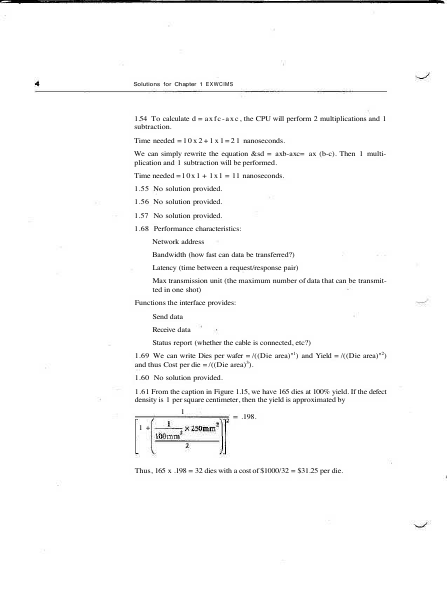

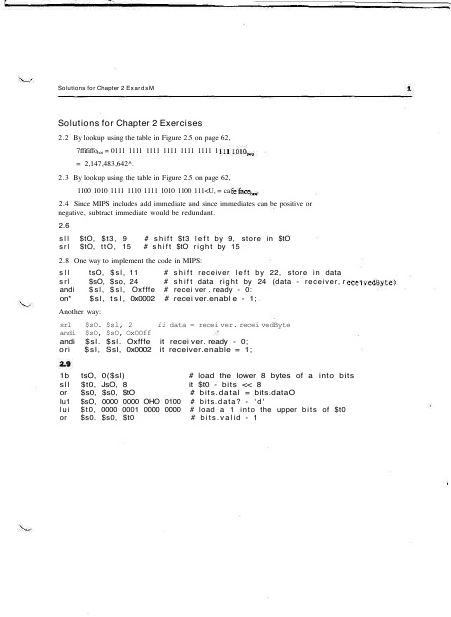
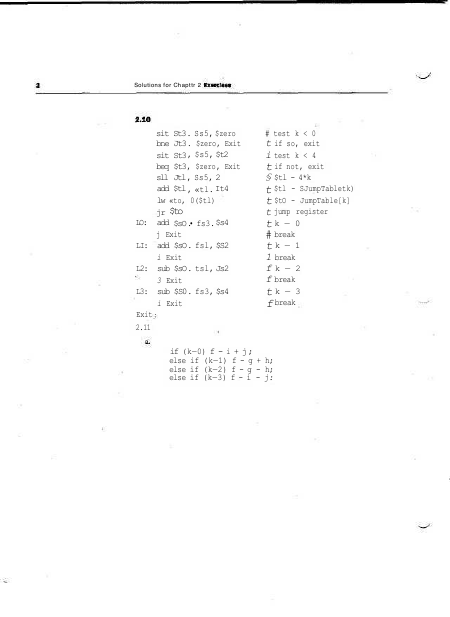
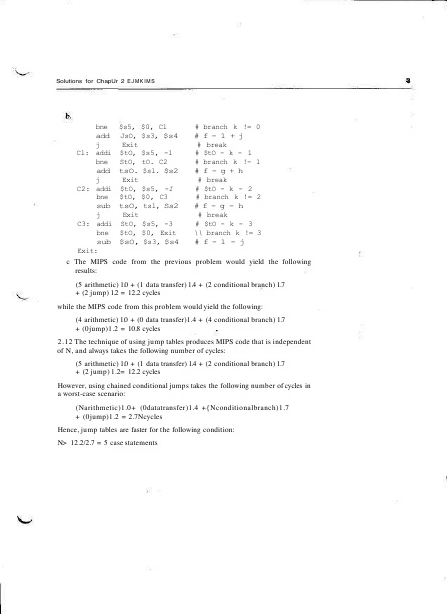








 2023年江西萍乡中考道德与法治真题及答案.doc
2023年江西萍乡中考道德与法治真题及答案.doc 2012年重庆南川中考生物真题及答案.doc
2012年重庆南川中考生物真题及答案.doc 2013年江西师范大学地理学综合及文艺理论基础考研真题.doc
2013年江西师范大学地理学综合及文艺理论基础考研真题.doc 2020年四川甘孜小升初语文真题及答案I卷.doc
2020年四川甘孜小升初语文真题及答案I卷.doc 2020年注册岩土工程师专业基础考试真题及答案.doc
2020年注册岩土工程师专业基础考试真题及答案.doc 2023-2024学年福建省厦门市九年级上学期数学月考试题及答案.doc
2023-2024学年福建省厦门市九年级上学期数学月考试题及答案.doc 2021-2022学年辽宁省沈阳市大东区九年级上学期语文期末试题及答案.doc
2021-2022学年辽宁省沈阳市大东区九年级上学期语文期末试题及答案.doc 2022-2023学年北京东城区初三第一学期物理期末试卷及答案.doc
2022-2023学年北京东城区初三第一学期物理期末试卷及答案.doc 2018上半年江西教师资格初中地理学科知识与教学能力真题及答案.doc
2018上半年江西教师资格初中地理学科知识与教学能力真题及答案.doc 2012年河北国家公务员申论考试真题及答案-省级.doc
2012年河北国家公务员申论考试真题及答案-省级.doc 2020-2021学年江苏省扬州市江都区邵樊片九年级上学期数学第一次质量检测试题及答案.doc
2020-2021学年江苏省扬州市江都区邵樊片九年级上学期数学第一次质量检测试题及答案.doc 2022下半年黑龙江教师资格证中学综合素质真题及答案.doc
2022下半年黑龙江教师资格证中学综合素质真题及答案.doc